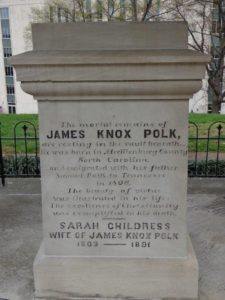“But the angel said to the women, “Do not be afraid; I know that you are looking for Jesus of Nazareth who was crucified. He is not here, for he has been raised as he said. Come see the place where he lay…” (Matthew 28:5-6)
It is no wonder, of course, that the guards thought this was the work of grave robbers, for they had never seen the likes of this before. Bodies three days dead do not normally just get up and go on their own.
 And so it is that these headlines caught my eye last week:
And so it is that these headlines caught my eye last week:
“President James K. Polk’s Body May Be Moved. Again.” (The New York Times)
“Plan to Dig Up Former President Polk Stirs Trouble” (The Columbian)
“Finding a Place for President Polk’s Body to Truly Rest in Peace” (Delaware Public Media)
And oh, isn’t it a story as old and deep and far reaching as people everywhere and in all times who gather at cemeteries to remember and to grieve? We leave markers behind in order to be able to return to the right place. We do so because the physical body is precious to us and it is normally in that physical form that we first come to know and love the one so buried. And when breath leaves one we have loved, for many it brings comfort to have an actual place to go for remembering.
Now I acknowledge that this is not universal and may not always be so, if current trends continue, for it is so that many people are not as rooted to a particular place as we once were. Indeed, it is impossible for some to even consider burying a loved one and then ‘leaving’ them, never to return, as lives are more mobile and we, as a whole, are not as likely to live in one place indefinitely. And yet, even with that, the ashes on the mantle or scattered in a special place, still carry meaning for us for they are what is physically left of who was so precious.
And so this week, the story as old and deep and far reaching as people gathering for such as this everywhere came home to me again as I overheard the debate about the fate of the body of President James K. Polk who is now in his third ‘final resting place’ and may be destined for a fourth. Never mind that poor James has been moved several times since his death in 1849. For evidently, first he was in a mass grave in the Nashville City Cemetery. He had died of cholera and this was a measure to prevent infectious diseases spreading from the corpses. Next he was moved to Polk Place grounds — the Nashville mansion which had been his home. However, the land was sold in 1893 after some kind of legal battle, so he and Sarah were moved to where they have now been for more than 100 years. Indeed, the family —however distant now —- these many generations later is stepping up and fighting back, disagreeing vehemently with the pending decision to move James and his wife, Sarah, from the grounds of the Tennessee capitol to his former residence in Columbia, Tennessee where he spent part of his childhood and where there is a museum named for him.
Maybe after all this time the powers that be thought there would be no one left would be interested enough to fight this. Perhaps their motivation is pure in that they think it will get more attention there than where it is now in a corner of the capitol grounds. More than that, it seems they think this is what President Polk would have wanted. To be buried in a place where he had lived.
It is hard to say, of course, but those engaged in the debate are taking this seriously. In fact, one state senator is saying he prefers legislators tread lightly around presidential corpses. Jeff Yarbro is quoted as saying,
“There are only 45 people who’ve been president of the United States, and if a few years from now there’s a crew with shovels in the front yard of the capitol, it’s going to be a national news story, and there’s going to be a lot of appropriate scrutiny on how this process got initiated.” (Washington Post, March 28, 2017)
And so it stirs something familiar up in us, this story, and again this week in a very real way as we consider the place where Jesus was buried, the women who followed him to his ‘final’ resting place, those who showed up that early Sunday morning who in deep distress believed that nothing good could have happened to have led to the body being gone — moved or stolen it must have been. For then, as too often now, we are invested in this flesh and bone and we cannot see beyond it to that day when it just won’t matter where the body is buried for this is not a place of life after all. Even if, as with President Polk, we once ‘lived’ there.
Oh yes, it strikes me now especially as we stand on the edge of another Easter celebration how we continue to cling to that which we have known and to honor what and who has been in the best ways we know. And yet, in no way do these reflect the promises of the day before us now.
This is why, as every year, my favorite Easter celebration is the one that happens early at Fairview Cemetery in DeKalb. We come together in a place where people have come for centuries to pause before a name and dates etched in stone. To speak a word, perhaps. To smile at a precious memory. To shed a tear which still needs to be shed, for while time surely heals, the wounds left by such loss are often still tender.This is my favorite service of Easter for I can think of no better place to remember that as Christ is risen, so will we be. So will we be to a time when a glorious future holds so much more than even the most blessed past. And in that time it simply won’t matter where President Polk is buried. Or my dad. Or your beloved child, your long grieved spouse, your best friend the likes of whom there will never be another. It won’t matter. For as the grave did not hold Jesus, it will not hold those whom God so loves, and it won’t be by legislative action by the likes of the state of Tennessee or because a crew with shovels has shown up, but because God IS love and light and healing and hope and promise. And life. God is life itself and that very life will be yours. Indeed, it already is as we stand still in the promise. It already is.
May You be Embraced by the Easter Promise of Life this Year!
